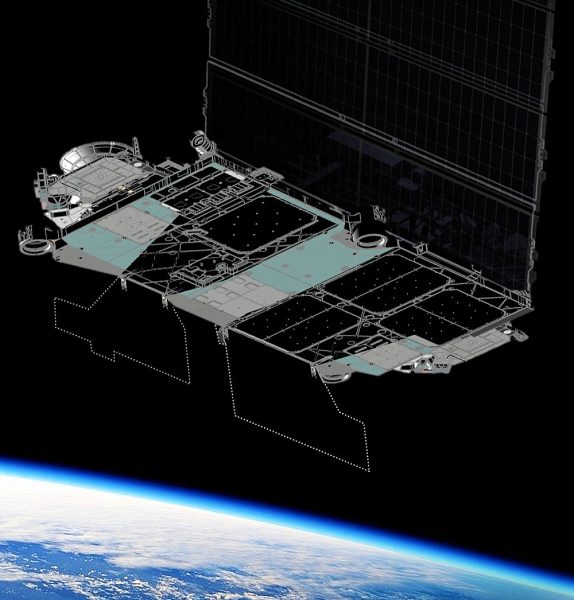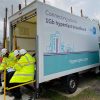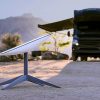Starlink Loses 40 LEO Broadband Satellites to Geomagnetic Storm

SpaceX appears to be licking some extremely expensive wounds today after the company revealed “up to” 40 of the 49 Starlink broadband satellites that it launched to Low Earth Orbit (LEO) on 3rd February 2022 will soon be toast, thanks to the impact of a pesky geomagnetic storm.
At present Elon Musk’s risky venture has around 1,900 LEOs in orbit and their initial plan is to deploy a total of 4,425 by 2024. Customers in the UK typically pay a hefty £89 a month, plus £54 for shipping and £439 for the kit (dish, router etc.). But for that you can expect unlimited usage, fast latency times of 20-40ms, downloads of c. 50-250Mbps and uploads of c.10-20Mbps (such figures will change as the network grows).
The company has been launching new Starlinks at a fair old rate of knots for the past couple of years, but they haven’t always gone according to plan, and some LEO platforms do fail (e.g. until today 132 had been disposed of and 36 have entered an early deorbit). But it looks as if the latest launch on the 3rd February has taken a particularly big hit.
Advertisement
Falcon 9’s second stage is stated to have deployed the 49 satellites into their intended orbit, with a perigee of approximately 210 kilometres above Earth, and each satellite achieved controlled flight. But shortly after that the same train of LEOs was struck by a geomagnetic storm, which caused the atmospheric drag on them to “increase up to 50 percent higher than during previous launches.” In short, they’ll end up being dragged back down to be vaporised in the Earth’s atmosphere.
Magnetic storms typically occur when intense solar wind interacts with Earth’s magnetosphere, which is the magnetic field that exists around our planet and helps to protect us from a lot of nasty solar and cosmic particle radiation. But this interaction, which spawns shifting currents and plasmas, can also cause the atmosphere to warm a little and atmospheric density to increase. Such things can be problematic for newly launched LEOs, which need to raise themselves high enough post-launch to stay in orbit.
SpaceX Mission Statement
SpaceX deploys its satellites’ into these lower obits so that in the very rare case any satellite does not pass initial system checkouts it will quickly be deorbited by atmospheric drag. While the low deployment altitude requires more capable satellites at a considerable cost to us, it’s the right thing to do to maintain a sustainable space environment.
Unfortunately, the satellites deployed on Thursday were significantly impacted by a geomagnetic storm on Friday. These storms cause the atmosphere to warm and atmospheric density at our low deployment altitudes to increase. In fact, onboard GPS suggests the escalation speed and severity of the storm caused atmospheric drag to increase up to 50 percent higher than during previous launches.
The Starlink team commanded the satellites into a safe-mode where they would fly edge-on (like a sheet of paper) to minimize drag—to effectively “take cover from the storm” — and continued to work closely with the Space Force’s 18th Space Control Squadron and LeoLabs to provide updates on the satellites based on ground radars.
Preliminary analysis show the increased drag at the low altitudes prevented the satellites from leaving safe-mode to begin orbit raising maneuvers, and up to 40 of the satellites will re-enter or already have re-entered the Earth’s atmosphere.
The deorbiting satellites pose zero collision risk with other satellites and by design demise upon atmospheric reentry—meaning no orbital debris is created and no satellite parts hit the ground. This unique situation demonstrates the great lengths the Starlink team has gone to ensure the system is on the leading edge of on-orbit debris mitigation.
SpaceX clearly attempts to put a positive spin on all this at the end, but there’s no escaping that it will be quite a costly failure to lose that many LEOs in one go. In the grander scheme of things, this won’t impact Starlink’s future launch schedule, but it’s definitely not what they would have wanted. Nobody ever said space was easy.
Mark is a professional technology writer, IT consultant and computer engineer from Dorset (England), he also founded ISPreview in 1999 and enjoys analysing the latest telecoms and broadband developments. Find me on X (Twitter), Mastodon, Facebook, BlueSky, Threads.net and Linkedin.
« Project Gigabit Updates on Start of First Live UK Procurements























































The Universe pushes back. Poetic really, like chucking a Fly tippers junk back in their own front garden.
You think the universe has magical powers?
Umm, I’ll go with the science thanks, which Mark also included a rather nice layman’s terms description of.
If you’re struggling to connect the universe pushing back with what’s occurred maybe you should read through that again.
Have a lovely day.
Whenever I read the comment sections around here I’m left feeling sick. Great articles though, thanks Mark.
I come for the articles, but I stay for the comments.
“meaning no orbital debris is created and no satellite parts hit the ground”
Ok, prob one for all those Einstein-ites out there, but what happens to all of the matter that was once the satellite? Is it a case of e equals mc squared (ie all turns to energy), or does it end up as “free” atoms that then “float around” or something, or what?
Expensive resources with a questionable environmental cost to produce Vaporised, Gone forever, not even factoring the launch vehicles footprint. It’s a shameful vanity project.
@Gary H the rockets are completely reusable and the exhaust fumes are literally water vapour.
I wouldn’t be surprised if you drive a diesel/petrol car daily and use gas for your central heating.
Hi Sam,
Well the rockets aren’t completely reusable are they, only the first stage.
Safe bet, you win we have a diesel car and actually burn kerosene for heating fuel, we don’t however burn close to 175,000 litres F9, or 400,000 litres F9heavy of RP-1 (also kerosene) in a shade under 3 mins.
Suggest you go do a little research on what’s left when you burn kerosene in a rocket, gas turbine or Ice, you might surprise yourself. It’s quite literally not water vapour
Interesting discussion above, but not (directly) related to my question. It did however set me thinking a bit more about what “burn up” meant in practice. A bit of Googling and I then found this article:
https://www.inverse.com/innovation/spacex-could-cause-geoengineering
From that it seems that we might well be in for an “interesting” time when all of these low earth satellites start to turn into airborne aluminium oxide. Climate change on steroids? I hope not!
Wirelesspacman, without being all eco doom and gloom about it, we spent decades dumping our waste in the oceans without a second thought banking on the fact it was basically too big for us to make an impact, so sure why not.
I know there a lot of guff about the environmental impact of rocket launches, I’m happy to be corrected but I believe a F9 launch roughly equates to the same emissions as a transatlantic 747 flight, So as an actual event its really not that significant in the big scheme of things, ie launches vs airplane flights globally
Well this is a stupid idea then, not that it wasn’t. If they aren’t capable of designing the satellites to be protected from everything nature is likely to throw at them in orbit, or won’t pay the costs to do so, then they will surely continually experience losses and the costs of the service won’t drop much?
The entire model is based on a 5 year lifespan per sat, even without the extra losses due to failure or events like this one, that’s one several reasons why I don’t like Starlink, (don’t think that’s a surprise to anyone here).
You’d think they’re be a polymer coating they could use to shield / protect them better against geo-magnetic issues like this????
From spaceXs site per Marks comments It wasn’t direct electro/magnetic damage as such but the increased drag in the upper atmosphere, slowing the sats before they were able to boost to operational orbit altitude.
Unlucky/bad timing for that phase of the deployment, a couple of days either way, ho hum.
Thats even worse then. You’d think the sats would have some automatic station keeping system to avoid this happening. Are they all independently controlled by a person from the ground then?
The satellites are initially put into an lower orbit while they go through a series to tests to check that they are functioning correctly before being boosted into a higher orbit. That way if during launch they have experienced damage, or the solar panels don’t work, they can be de-orbited far quicker.
The Scott Manley video lower down, covers the problem they experienced really well. But neither the less, cost is a factor in the reason they couldn’t get themselves out of trouble.
The video does a good job of explaining the layers of the atmosphere 🙂
So, Scott Manley gives a very good explanation of what happened.
https://youtu.be/9kIcEFyEPgA
Thanks for that link. Pretty good explanation that.
Also, for anyone interested, https://www.youtube.com/watch?v=VIQr1UyhwWk is also good background to how Starlink (and OneWeb) in general
Oops!
… get into orbit.
I guess this is the answer as to why its £500 a month….
More the cost of ones that function correctly, despite this being a big loss.
Figures generally seem to estimate 250k per sat and a cost to SpaceX of 15 million to launch a reused falcon, so lets say 500k per sat to orbit over a 5 year lifespan, so 100k a year each multiplied up by however many are in orbit.
Not counting the production costs of actually building the first and second stages the loss of the second stage on re entry and then the running costs of all the ground stations staff etc.
Aliens are to blame for EVERYTHING!!!